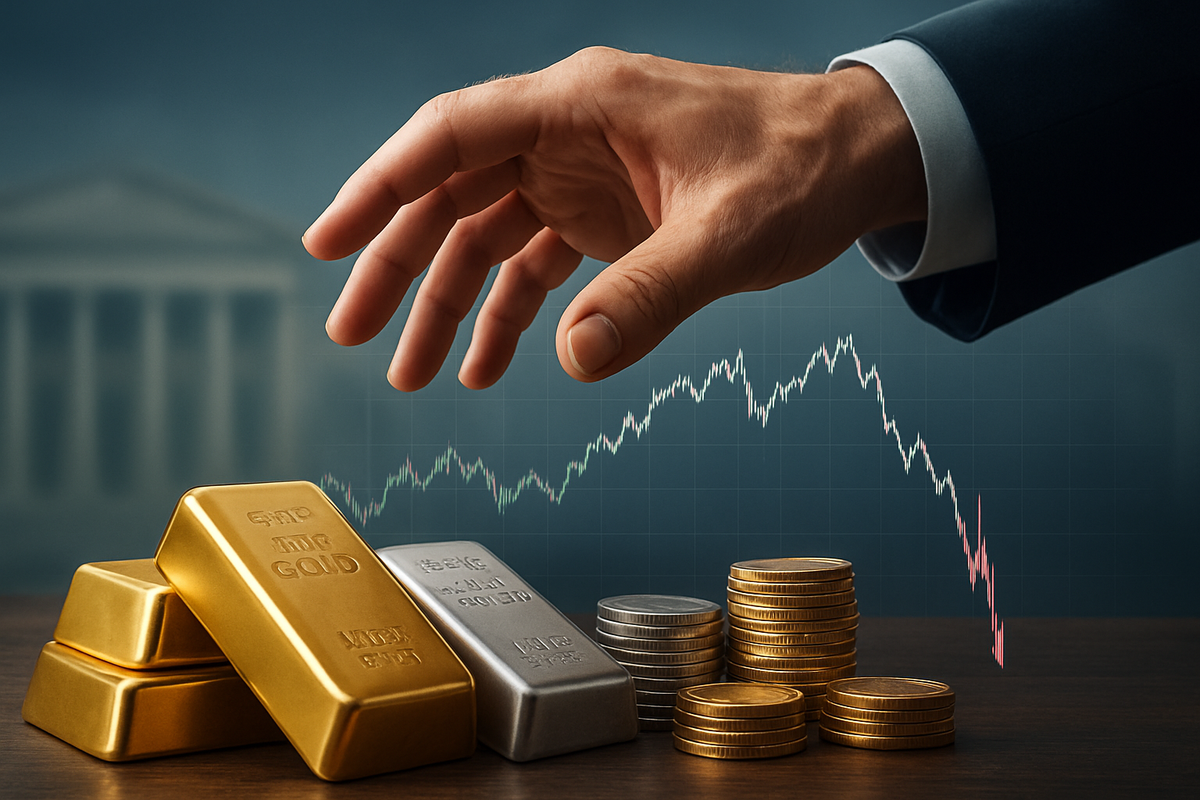
November 14, 2025 – In a dramatic turn of events, recent hawkish pronouncements from Federal Reserve officials sent shockwaves through the precious metals market today, causing a sharp downturn in both gold and silver prices. The assertive rhetoric, which largely tempered market expectations for an imminent interest rate cut in December, triggered significant sell-offs, particularly impacting non-yielding assets. Despite this immediate slump, both gold and silver managed to defy the intraday pressure, remarkably securing overall weekly gains, highlighting a complex interplay of market forces.
The pronounced slide in prices on November 14, 2025, was a direct consequence of the Federal Reserve's firm stance, which signaled a less accommodative monetary policy than many investors had anticipated. This shift in sentiment quickly translated into a rush to liquidate positions in gold and silver, assets traditionally favored during periods of economic uncertainty and lower interest rates. However, the metals' ability to maintain weekly upward momentum underscores persistent underlying demand driven by broader global economic anxieties and a weaker U.S. dollar observed earlier in the week.
Detailed Coverage: Fed's Firm Hand and Market Reaction
The catalyst for today's market turmoil was a series of explicit and hawkish statements from various Federal Reserve officials, including Chairman Jerome Powell. These officials unequivocally communicated that another interest rate cut in December was "not on the cards" or expressed significant caution regarding the potential for an overly accommodative monetary policy. Their concerns primarily revolved around persistent inflationary pressures and a resilient labor market, suggesting that the economy might not require further stimulus as previously speculated by some market participants.
This hawkish rhetoric immediately recalibrated market expectations. Data from CME Group's FedWatch tool, which tracks the probability of future rate changes, showed a noticeable decline in the perceived likelihood of a December rate cut. What had earlier in the week been a 64-67.8% expectation for a cut, plummeted to approximately 47-53% following the Fed's comments. This shift was a critical factor in eroding the appeal of gold and silver, as higher interest rates typically increase the opportunity cost of holding non-yielding assets.
The immediate market reaction was swift and severe. In the domestic Indian market, gold prices experienced a significant plunge, shedding nearly Rs 5,000 per 10 gram to hit a day's low of Rs 1,21,895. Internationally, spot gold witnessed a substantial drop of over 3% on the day, falling by $104.50 to $127 per troy ounce, with December gold futures also mirroring this decline. Silver, known for its higher volatility, suffered an even more pronounced impact, with domestic rates plummeting by Rs 8,700 per kilogram to a day's low of Rs 1,53,729. On the COMEX, silver prices fell by $1.68, or 3.21%, with December silver futures also experiencing sharp falls. Adding to the downward pressure was aggressive profit-taking and the liquidation of long positions by short-term futures traders, further exacerbating the sell-off in both precious metals.
Compounding the pressure on gold's safe-haven appeal was the recent conclusion of a prolonged 43-day U.S. government shutdown. With the resolution of this political uncertainty, a key driver for safe-haven demand dissipated, contributing to the overall decline. Despite these significant intraday losses, both gold and silver managed to close the week with gains. Gold was on track for its first weekly gain in four, rising between 1.4% and 4.5%, while silver showed even stronger performance, surging by 4.6% to 7.8% over the five-day period. These weekly gains were primarily underpinned by earlier safe-haven demand stemming from broader global economic uncertainties and a weaker U.S. dollar, which makes dollar-denominated commodities more attractive. Additionally, continued central bank purchases of gold provided a long-term supportive factor.
Companies in the Crosshairs: Winners and Losers
The volatility sparked by the Federal Reserve's hawkish comments creates a mixed bag for public companies operating within the precious metals sector. Mining companies, exchange-traded funds (ETFs), and even financial institutions involved in commodity trading will feel the immediate and potential long-term effects.
Mining companies, particularly those with significant exposure to gold and silver, stand to be most directly impacted. Companies like Barrick Gold (NYSE: GOLD), Newmont Corporation (NYSE: NEM), and Agnico Eagle Mines Limited (NYSE: AEM), which derive substantial revenue from the extraction and sale of these metals, could see their stock prices fluctuate in response to commodity price movements. A sustained downturn in gold and silver prices, driven by higher interest rates and a stronger dollar, would erode their profit margins and potentially reduce their exploration and development budgets. Conversely, if the market perceives the current slide as a temporary correction within an overall bullish trend for precious metals, these companies might experience a rebound as investors look for long-term value. Their ability to manage operational costs and maintain healthy balance sheets will be crucial in navigating this volatile environment.
Exchange-Traded Funds (ETFs) that track gold and silver, such as the SPDR Gold Shares (NYSE: GLD) and the iShares Silver Trust (NYSE: SLV), are directly exposed to the price movements of the underlying commodities. Investors holding these ETFs would have seen a sharp decline in their value on November 14, 2025. For short-term traders, this presents both risks and opportunities – a chance for quick profits for those who shorted the market, but losses for those holding long positions. For long-term investors, the question becomes whether the Fed's stance fundamentally alters the investment case for precious metals, or if these are merely short-term headwinds. Furthermore, financial institutions involved in commodity derivatives and trading desks could see increased activity and potential for profit from heightened volatility, but also face risks associated with managing large positions in a rapidly changing market.
Companies that benefit from a stronger U.S. dollar, which often accompanies a hawkish Fed stance, might indirectly gain. For instance, U.S.-based companies with significant international operations that report earnings in dollars could see favorable currency conversions. However, the direct impact on precious metals companies is primarily negative in the short term due to the inverse relationship between interest rates, the dollar, and commodity prices. The resilience shown by gold and silver in achieving weekly gains suggests that underlying demand factors could still provide support, potentially mitigating the long-term negative impact on these companies if the broader economic outlook remains uncertain or inflationary pressures persist.
Wider Significance: A Shifting Economic Landscape
The Federal Reserve's hawkish pivot, and its immediate repercussions on gold and silver, signal a potentially significant shift in the broader economic landscape. This event fits into a larger trend where central banks globally are grappling with persistent inflation while trying to avoid tipping economies into recession. The Fed's explicit pushback against immediate rate cuts suggests a stronger commitment to inflation control, even if it means tolerating higher interest rates for longer. This stance could have ripple effects across various sectors, influencing everything from consumer spending to corporate investment.
Historically, periods of rising interest rates and a strong U.S. dollar have typically been challenging for precious metals. Gold and silver, as non-yielding assets, become less attractive when bonds and other interest-bearing instruments offer better returns. This current scenario echoes similar periods in the past where a determined Fed tightened monetary policy to combat inflation. For instance, the early 1980s under Paul Volcker saw aggressive rate hikes that severely impacted commodity prices, though the economic context was different. Comparing to more recent times, any hint of monetary tightening often leads to a knee-jerk reaction in the gold market, as witnessed today.
The ripple effects extend beyond the precious metals sector. A sustained hawkish stance from the Fed could lead to a stronger dollar, making U.S. exports more expensive and imports cheaper. This could impact multinational corporations (MNCs) and their competitive positioning globally. For emerging markets, a stronger dollar can make dollar-denominated debt more expensive to service, potentially leading to capital outflows. Furthermore, the Fed's commitment to fighting inflation could set a precedent for other major central banks, potentially leading to a synchronized global tightening cycle, which would have profound implications for global trade and economic growth.
Regulatory and policy implications are also at play. If inflation remains stubbornly high, the Fed might face increased political pressure to continue its hawkish stance, potentially leading to further policy adjustments. The current situation highlights the delicate balance central banks must maintain between price stability and economic growth. The market's reaction also underscores the sensitivity of asset prices to central bank communication, emphasizing the need for clear and consistent messaging to manage expectations and avoid undue volatility. The resolution of the U.S. government shutdown, while removing one source of safe-haven demand, also signifies a return to more conventional market drivers, allowing monetary policy to take center stage.
What Comes Next: Navigating the Uncertainty
The immediate aftermath of the Federal Reserve's hawkish comments sets the stage for a period of heightened uncertainty and strategic recalibration across financial markets. In the short term, gold and silver prices are likely to remain highly sensitive to further statements from Fed officials and incoming economic data, particularly inflation reports and employment figures. Any indication that inflation is cooling faster than expected, or that economic growth is faltering, could quickly reignite expectations for rate cuts, providing a potential tailwind for precious metals. Conversely, continued strong economic data and persistent inflation could reinforce the Fed's hawkish stance, maintaining downward pressure.
For investors and market participants, adaptability will be key. Short-term traders will look for opportunities in volatility, potentially employing strategies that capitalize on price swings. Long-term investors in precious metals may need to re-evaluate their positions, considering whether the fundamental drivers for gold and silver—such as safe-haven demand and inflation hedging—are sufficiently strong to offset the impact of higher interest rates and a stronger dollar. This might involve diversifying portfolios or adjusting allocations to precious metals.
Potential strategic pivots or adaptations required for mining companies include a renewed focus on cost efficiency and capital preservation. If commodity prices remain subdued, companies may need to defer less profitable expansion projects and prioritize high-grade, low-cost operations. Exploration budgets might be trimmed, and mergers and acquisitions could become more attractive as companies seek to consolidate resources and reduce overheads. For investors, this could mean favoring mining companies with robust balance sheets and proven operational efficiency.
Market opportunities could emerge in sectors that benefit from a stronger economy and higher interest rates, such as banking and certain segments of the technology sector. However, the overarching challenge will be navigating the potential for a global economic slowdown if aggressive monetary tightening by major central banks stifles growth. Potential scenarios include a "soft landing" where inflation is brought under control without a severe recession, or a "hard landing" involving a more significant economic downturn. The latter would likely see a resurgence in safe-haven demand for gold, despite higher interest rates, as investors prioritize capital preservation.
Wrap-Up: A Test of Resilience for Precious Metals
The Federal Reserve's recent hawkish comments, delivered on November 14, 2025, represent a critical juncture for the precious metals market, underscoring the profound influence of monetary policy on commodity prices. While gold and silver experienced a sharp intraday slide, driven by tempered expectations for a December rate cut and a stronger dollar, their ability to secure weekly gains highlights the inherent resilience of these assets and the complex interplay of various market forces. The key takeaway is that while central bank actions can create significant short-term volatility, underlying demand factors, such as geopolitical uncertainty and long-term inflation concerns, continue to provide a floor for precious metal prices.
Moving forward, the market will be closely watching the Federal Reserve's subsequent communications and the trajectory of key economic indicators. Any signs of easing inflation or a weakening labor market could prompt a shift in the Fed's tone, potentially providing renewed impetus for gold and silver. Conversely, a sustained commitment to higher rates could prolong the challenging environment for non-yielding assets. Investors should also monitor global economic developments, as any escalation of geopolitical tensions or signs of a broader economic slowdown could bolster safe-haven demand, irrespective of interest rate dynamics.
The lasting impact of this event will depend on whether the Fed's hawkish stance is a temporary adjustment or a sustained policy shift. For now, gold and silver remain in a tug-of-war between the gravitational pull of higher interest rates and the supportive lift of ongoing uncertainty and intrinsic value. Investors should prepare for continued volatility, conduct thorough due diligence, and consider a diversified approach to navigate the evolving financial landscape. The coming months will be crucial in determining the long-term trajectory for these ancient stores of wealth.
This content is intended for informational purposes only and is not financial advice






